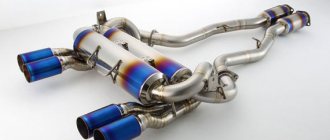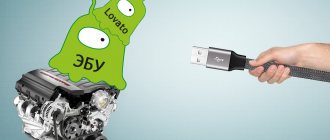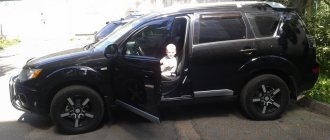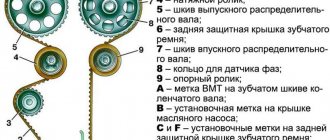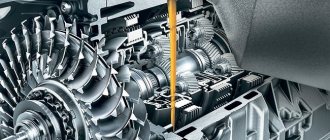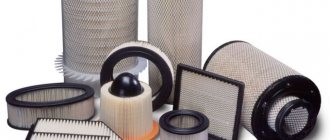What is this exit for?
The Aux line output in the radio is necessary to connect a smartphone, tablet or mp3 player to the player. In this case, the sound will be transmitted through the car speakers.
In some cars they are combined, and the car owner can connect the phone when answering a call. To do this, you can connect a microphone to the radio via AUX. Therefore, on the panel on top of the Aux connector it is written “AUX IN”.
In operating condition, a signal with an amplitude in the range of 0.5-1 V is supplied to the output.
There is also an amplifier that transmits sound to the speakers.
Some drivers do not know what the input in the radio with the inscription AUX means. In this case, you can mix up 2 identical connectors. Below the output with the prefix “IN”, there is a plug labeled “OUT”.
AUX OUT - a connector designed for audio output. Therefore, a wire is inserted into it to output music. Speakers are suitable for this. Unknowing motorists are faced with problems with sound output in the radio and have no idea what Aux is. Therefore, if problems arise with the volume or the player does not work, they change it, but the problem may be that the device is not connected correctly.
Method 1: USB connection
This is possible if the radio has a USB port. Modern “music players” in cars are equipped with a USB port, which cannot be said about outdated models. The connection looks like this:
- Use a USB to MicroUSB cable and connect one end to the car device and the other to your phone.
- On your phone, select the USB connection option “Data Transfer”.
- Ready. Play music.
In this case, there can be 3 models of radio behavior:
- They become passive - they play music from the phone and no additional actions can be performed on them.
- With management functions - by pressing buttons on the car gadget you can switch the track, stop the song, turn up the volume.
- Full duplication - management functions + moving through the phone's music catalog, and other options.
Additionally, if you connect the phone to the radio via USB, the phone can be recharged as if from a computer.
How to use
When the Aux connector is detected on the car radio, the driver tries to determine what it is and how to use this function. The system can be found in many devices that reproduce sound. However, older cassette players or older versions of CD radios do not have a line-out. But this does not mean that a car enthusiast will not be able to connect a player or smartphone to play his music on the speakers.
To start listening to music in the car, you will need to determine how the playback device is connected via Aux and start listening to music from other sources. If the radio has an AUX plug, then to start using it you need a wire, where the jack size should be 3.5 mm. On the other side of the adapter there are several connectors for connecting an external device. If the corresponding output is not found on the player, then the car owner is able to make it himself. After connecting the playback device, you can listen to music.
How to enable AUX
If AUX was originally built into the car radio, then the system will need to unlock it. To enable Aux on the radio as a device that sends a signal to the speakers, you need to put the player in standby mode. To do this, press the SRC button, then enter the menu using MENU. You will need to hold the button until the system is activated. In the menu, scroll the right control knob to toggle Aux. The car radio display may show AUX ON/OFF, which indicates whether the input is on or off.
After the radio display says that Aux is on, press the MENU button. This will help you log out and save your settings. Then you can connect the AUX wire to the radio.
Bluetooth adapter
If for some reason it is impossible to use standard adapters, then you can purchase a Bluetooth adapter. The device connects to any 3.5 mm jack connector. In the car radio, the Bluetooth adapter is connected to the AUX input. The device wirelessly transmits an audio signal. The advantages of connecting AUX with a Bluetooth adapter include:
- Wireless signal transmission. Wires in the cabin interfere with the driver and look ugly.
- High-quality audio codec. Playback of audio tracks occurs without jamming, and a clean signal is output.
- Convenient and easy to use. The adapter is connected directly to AUX and connected to the car radio without additional actions or manipulations; To turn it on, press the button.
- Output sound from multiple devices. The adapter provides for connecting 2-3 external devices.
- Bluetooth is easy to use. You can switch music or adjust the volume using your voice or remote control; if necessary, use the buttons on the device body.
An adapter connected via AUX to a player in a car costs around 500 rubles. Minor disadvantages include the fact that the device requires recharging.
Cable
In addition to the adapter, there is a special AUX cable for the car radio, which is sold in a car equipment store. It can be found in the accessories section. Sometimes the adapter is already included in the factory configuration.
In this case, the connector should be on one side, as for 3.5 mm jack headphones, and on the other, intended for a smartphone or other external device with music. To connect the cable to the radio, you will need to connect the Aux in the menu, and then you should not confuse the 2 outputs and insert the plug into the Aux labeled “IN”.
Using external adapters and cables
The review would be incomplete without adding that in today’s market a driver can find many devices whose functionality is capable of not only providing a linear input. There are models with support for USB AUX and Bluetooth. Installing such a model is no more difficult than described above. In the video below, the owner connects such a device without disabling support for factory devices.
If your radio does not support connecting external sound sources, every car enthusiast can add this option.
How to make AUX
If the player in your car does not have a line input, then it is useful to know how to output music from devices. To do this, you will need to make a plug in the radio with your own hands. Car owners begin to think about how to make an AUX input if there is none, and begin to purchase the necessary tools. First you need to purchase a wire and plug. You don’t have to buy them in the store, because... The connector can be removed from old headphones. To avoid problems after connection, the wire must be taken without damage.
The jack connector in the headphones is divided into 3 parts. In this case, the largest colored wiring at the base relates to the overall sound. To solder the parts you will need to use a soldering iron. Additionally, you need to take solder and a multimeter.
CD on the radio
The disc player is equipped with an AUX input. Some manufacturers do not display it on the dashboard and do not know how to listen to music from an MP3 player. Therefore, the car owner must do this himself. To solder the Aux into the player, you will need to stock up on tools and consumables such as:
- medium Phillips screwdriver;
- knife;
- a set of standard keys to remove the radio;
- jumper from the computer's HDD drive;
- headphone wire;
- jack 3.5 mm;
- insulating tape;
- USB cable.
To make AUX in the radio, you will need to remove the decorative plates - to do this, you can use a knife and carefully pry them off. Then take a medium Phillips screwdriver and unscrew the 2 screws holding the grille. Once this is done, the mesh will come away and can be easily removed. The procedure helps to open access to the radio with a CD drive; You can make an AUX input using standard keys. This is necessary to remove the player from its niche.
After removing the car radio, you should examine the back wall of the case and find the white connector.
Instead of this output there will be an Aux input. After finding the connector, you should connect the USB cable and jumper from the HDD drive to it. Then you need to close the contacts. To install the jumper correctly, you will need to divide the upper part into even contacts, and the lower part into odd ones. To create an Aux input, jumper the bottom pins 11 and 13, counting from the left side.
Then a USB cable consisting of the following elements is connected to the input:
- left channel cable;
- right channel wire;
- shielding.
For the right channel, pin 5 is used, and for the left, pin 3 is used. Both wires are connected to a two-core cable and the connection is insulated with electrical tape. The cable and jumper are inserted into the connector of the player in the car. The creation procedure is completed, and AUX is removed not from the radio, but into the ashtray. A cable with a USB connector can be connected to the player or other devices. Soldering in the connector yourself makes it possible to use not only a USB cable; instead, you can use other adapters to connect external devices.
On the standard radio
Soldering an AUX adapter for a standard radio is not an easy process. In this case, the player is removed due to the fact that there is not always an input on the panel. In addition to the basic tools, to make the connector, you will need to prepare 3 insulated cables. The cross-section of each of them should be 0.5 cm, and the length should be 30 cm. Additionally, heat shrinkage will be required.
To connect Aux to the standard radio, you need to remove the decorative strips with a knife. A similar procedure is done with the panel near the gear shift lever. Then it is removed manually, after which access to 2 screws opens. To do this, use a Phillips screwdriver. Installation of AUX in standard radios is carried out by removing the device from the niche.
To avoid damaging anything, when removing the player, you must disconnect all the wires at the back.
Then you need to take a Phillips screwdriver and unscrew all the bolts that hold the car radio cover. The device can now be removed from the case. To install AUX in the standard radio, you need to find the following 3 points on the board:
- LCH. Indicates left stereo channel.
- RCH. Right stereo channel.
- GND. "Earth".
It is necessary to solder 3 wires to the designated contact points. After this, all cables are assembled and heat shrinked to ensure the structure is safe. The procedure for soldering the AUX is completed, and all that remains is to assemble the player.
All parts are installed in reverse order. The resulting three-wire wire is connected to the standard radio and brought out into the glove compartment or car interior, after which all that remains is to connect the 3.5 mm jack. A soldering iron is used for this. After completing the procedure, you can connect other devices to listen to music on the car speakers.
On a cassette player
If the car has an outdated player, and the owner wants to connect an AUX input to listen to music from an external device, then he will need to make a socket with his own hands. The set of tools is no different from other installation methods. The process begins with unscrewing the bolts holding the player in the niche. Then the player is removed and the screws are unscrewed from the car radio cover. After this, the tape mechanism of the cassette recorder becomes available.
The device is attached to special metal finish latches. Connecting the AUX input to an old radio is done either by removing the mechanism or leaving the structure in place. This depends on whether the device will interfere with getting to the volume control. Then the three-pin volume control is removed from the player. You need to solder 3 wires to it:
- general;
- for the left channel;
- for the right stereo channel.
Pairing your phone and radio via USB
The USB adapter is a universal tool; it can be used to connect various types of devices. To transfer audio from a phone to a car radio, certain connectors (sockets) are required through which the adapter is connected.
The USB connection allows you to control the phone through the radio and in the opposite direction.
While data is being transferred to the playback device, all other mobile phone applications remain available and can be used.
To connect via an adapter, you do not need to perform complex manipulations or additional settings. Devices begin to “see” and perceive each other automatically. Some models ask the administrator for access permission, then no difficulties arise during operation.
The positive aspects of using a USB connection to connect a phone:
- The phone's battery does not drain as quickly as when connected via Bluetooth.
- The mobile phone requires recharging less often, since while transmitting information to the radio through the adapter, its battery is simultaneously recharged.
- The phone can be controlled through the radio screen, and the playback device through a mobile phone.
- During the transfer of information, all other applications and functions of the phone remain available and can be used. This is especially valuable when you need to make a call or use the navigator in your smartphone.
There are not many disadvantages to this method:
- A constantly connected and hanging wire can get in the way;
- Old radios do not see “audio files” in new phone models or cannot play them.
Video manual for connecting devices
When the user does not understand exactly how and into which socket the USB cable should be connected, they should study the manual, which clearly describes all the actions that need to be performed.
The video instructions describe how to connect your phone to the car radio:
Problems and how to solve them
After soldering or on a standard radio, car owners have problems with sound transmission.
At the same time, they note that the volume is low, or the player does not work at all.
Plays quietly
If the sound coming through the Aux into the device is weak, this may be due to damage to the wire. To fix the problem, you need to check the connection cable. To do this, use a multimeter.
If the device does not show any problems, then you should increase the volume on the connected device.
Does not work
Car owners note that the player does not make sound. If AUX does not work, this may be due to the fact that the connector in the radio is turned off. Otherwise the wire would be connected to Aux OUT.
To solve these problems, you should go to the device menu and check whether the input is unlocked or not. Sometimes the problem occurs in the socket - to do this you will need to remove the radio and check the connection of the contacts.
The existing Clarion DB2655 radio receiver picks up three radio stations (fortunately, Vladivostok also broadcasts in the Japanese band), the CD did not work until I picked up one disc, from which the recognition mechanism started, after which it reads almost everything. I do not accept the installation of an FM converter, as well as an FM player, for reasons of minimal sound quality. Previously, I had a car with a radio that had a 7-pin round input at the back for connecting an external CD changer, I soldered a toggle switch that supplied + 12V to one leg (according to the description, 5V is needed, but nothing burned out from too much in a couple of years) and wire from old headphones with a mini-jack connector. You turn on the toggle switch, the tape recorder is switched to amplifier mode, the wire from the headphones to the player and you listen to music. There was no such connector here...
We remove the bottom cover, look at the place where the radio module is soldered: the legs are labeled “L-out” and “R-out”:
At the same time, I soldered the power contacts of the radio (on the board it was clear that the soldering was cracked) and an additional capacitor (4700 µF/25V) for the power supply (as close as possible to the output microcircuit, on the wiring; placed behind the back wall).
I also powered the radio with a separate 2x2.5 mm cable from the battery.
When the input is not connected and the frequency is set to 90.0 MHz (free from radio stations), only when the volume control is set to maximum (30) is a rustling noise heard, i.e. in fact, nothing extraneous is monitored. Result: MUSIC IS PLAYING; Well, in the “Z-Enhcr-3” mode and the “MB EX” is turned on and the regulator is set to “22”, the mirror shakes, the screws unscrew themselves. Later I supplemented my design with an adapter for headphones from Nokia N78, cutting off the clothespin on the back and gluing it to the panel with 2-sided tape:
Materials and tools: old headphones, knife, natfel, soldering iron, rosin, solder, aspirin (tinning headphone wires), a piece of hot-melt glue stick, double-sided tape.
Are there any disadvantages to connections?
The main disadvantage of using wireless technology to listen to music in a car is the sound quality. Although it is more convenient in the long run, the music quality will be worse with Bluetooth than with an additional aux connection.
The reason why music over Bluetooth isn't as good is because of the way devices use technology to transmit sound. Instead of sending an uncompressed analog signal like a physical aux connection, sending music over a wireless Bluetooth connection involves compressing the audio at one end and then expanding it to the other device.
Because Bluetooth audio transmission involves a form of lossy compression, some level of fidelity to the music is lost when you use this type of connection. It is possible to transfer data via Bluetooth as complete files without losing anything, but this goes against the scenario of this type of use case.
If you don't know what this means and you have a Bluetooth headset or headphones at home, try connecting them to your computer. If the device has the ability to connect to the Bluetooth audio-visual profile or the phone profile, try each, and check the difference in night and day time between them.
When you choose to use headphones or Bluetooth headphones on your computer through a "headset profile," music streamed to and from the device is encoded at 64 kbps or PCM, and the profile also allows you to use minimal controls such as answering calls and making adjustments volume.
When you choose to use headphones or a Bluetooth headset on your computer through the "Advanced Audio Distribution Profile," audio is delivered using the low-complexity SBC codec, although the profile also supports MP3, AAC, and others.
The difference in music quality between these two profiles is so obvious that anyone can immediately choose which one is worse. Although the difference between Bluetooth and aux is not that great, some level of audio fidelity is lost with Bluetooth even with the A2DP profile.
see also
Comments 33
but it would be better to install a mother, and a prosod with two folders, then you would have already pulled out the plug and the receiver would work automatically, and you wouldn’t have to climb to switch the button
This was suggested later... To be honest, before the trip I decided: radio or my music, clicked and listened.
Then I improved the radio with a black package (www.drive2.ru/l/5521074/) and now I drive like that.
And I brought out not a “folder”, but a “female” to a 3.5 jack, soldered off from a broken Chinese receiver. It has two contacts with breakers. Connection to the phone via a male-to-male cable. When the plug is not inserted - the contacts are closed in the connector and the radio is working, insert the plug - the contacts open and a signal comes from the phone. Something like this…
I also did a similar thing on a Panasonic radio, but I didn’t cut the tracks, I just connected it to the outputs from the FM receiver, which is interesting, even when the radio is playing, when you connect a player (phone), the radio is muted almost to 0 automatically
Maybe because the output impedance of the player is matched to the impedance of the headphones, so the receiver output is pushed down...
I need to get a headset like this with controls, but it’s not safe to poke your phone while driving)))
Great idea, I'll take note. I’ve already read something like this somewhere, but never got around to it? cnjbn pioneer deh-7700mp? There is no AUX or USB input, it accepts disks, but when reading it it says ERROR1. IT'S A PITY! So far I've come up with the following to listen to music from a flash drive: I bought an FM adapter, I found a square one with a remote control, I cut out a suitable hole in the beard near the box (as it grew there))), connected a USB extension cord to it, and made a separate socket nearby to insert the flash drive . Since I installed a stove regulator from Kalina, the original button for turning on the stove remained unused. So she was needed! -> I wanted to turn on the flash drive -> I pressed the button, the modulator turned on, all I had to do was press 1 button on the radio and the saved wave 90.0, to which the adapter was configured, would turn on. That's all. True, I noticed that when you’re driving, and someone in a neighboring car has a similar adapter, the songs interrupt each other. You also need to make your own plug.
Bluetooth
This type of phone connection to the car radio does not require the purchase of additional equipment or cords. Modern car radios have a built-in Bluetooth wireless module. It allows you to synchronize between two devices: a radio and a smartphone.
Thanks to this, car owners can talk on the phone through the speakers in the car and listen to music from the gadget. To perform synchronization, launch Bluetooth on the car radio and smartphone. Playback control is carried out either through the phone or through the radio - it depends on the car’s audio system.
What is AUX output
This is a small connector to which you can apply voltage in the range from 0.4 to 1.9 volts. We call it a linear output, but in Western machines it is designated as “AUX-OUT” (and a little earlier it was designated as “CD-OUT”) . If a device has such an output, it almost certainly means that it is also equipped with an audio amplifier. Therefore, by connecting a tablet or smartphone to this connector, you can listen to music collections directly through the car’s speakers.
The problem is that on old radios there is not always such an output. And if a car owner wants to listen to some file from his smartphone in the car, then he will have 2 options:
- Buy a new radio with an AUX output (which is quite expensive).
- Try installing the AUX output yourself.
In this article we will focus on the second option.
AUX in car
Over the past ten years, smartphones and other portable gadgets have become an integral part of our lives. The advent of smart phones has had an impact on all areas of human activity. And the auto industry was no exception. Experts have begun to focus on the interaction between a smartphone and a car. The appearance of AUX in the car was the first step towards the integration of mobile devices.
The AUX jack on your car's audio system looks like a small round hole with a metal surround. Usually it is located on the body of the radio. If the connector is not there, then perhaps it is located in a specialized niche for ports. If you are the owner of an expensive imported car, the socket can be covered with a lid that protects the contacts from dirt and moisture.
Installing an AUX output on a CD radio
It should be noted right away that the vast majority of such car radios are already equipped with AUX connectors, but for some reason manufacturers do not consider it necessary to display them on the dashboard. The car owner will have to solve this problem on his own.
Tools and Supplies
- Phillips screwdriver (medium size).
- Knife.
- Insulating tape.
- A set of standard keys for removing a CD radio.
- Wire from a computer USB controller.
- Jumper from the computer hard drive.
- Headphone cable with 3.5 mm plug.
Sequence of actions when installing an AUX output on a CD radio
- The decorative plate is removed from the radio (it is best to carefully pry it off with a knife). Then, using a Phillips screwdriver, unscrew the 2 screws on which the grille is attached. After unscrewing the screws, it rises up:
The ventilation grille above the radio has been removed from the screws and moved back
Removing the radio from the niche is done using standard keys
Connector for subsequent connection of an AUX cable
From left to right: USB cable, jumper from the hard drive and 3.5 mm plug from regular headphones
The jumper and USB cable must be installed as shown in this diagram
Ready-made insulated AUX cable
Cable and jumper connected to the radio connector
Ready AUX output for connecting a smartphone or tablet
Video: independent connection of the AUX output to the car radio
Where did the auxiliary connectors come from?
Car stereos have supported auxiliary jacks for a long time, so it's tempting to ditch the outdated technology. The 3.5mm auxiliary port on the front of the car stereo is based on technology that has not changed since 1960.
The AUX jacks on car radios are analog connections that have been called telephone jacks, stereo jacks, headphone jacks, and other names over the years. The same basic type of plug was used to connect everything from phones, to electric guitars and microphones, to headphones and everything in between.
The technical term for this type of aux connection is TRS or TRRS, which stand for "Tip Ring Sleeve" and "Tip Ring Sleeve" respectively. These names refer to the physical metal contacts present on the specific auxiliary input.
Most car audio systems include a TRS connection, which is designed to make it easy to send an analog audio signal from a phone or other audio output to the car's head unit, much like connecting a set of headphones.
There are some problems with this type of audio connection, and when running an analog signal for tiny headphones into a stereo system you are likely to encounter some music quality issues. Using a line-out instead of headphones or speakers, or using a digital USB connection instead of an analog auxiliary connection are both ways to solve this problem.
Installing an AUX output on a standard car radio
The main problem with stock radios is that they are very difficult to remove. There is a second problem: not all standard radios have external AUX connectors, so you will almost certainly have to disassemble the radio itself.
Tools and Supplies
- 3 insulated wires with a cross section of 0.5 cm and a length of 30 cm.
- Headphone plug 3.5 mm.
- Heat shrink.
- Soldering iron.
- Phillips screwdriver (medium size).
- Knife.
Sequence of actions when installing an AUX output on the head unit
- The decorative strip located above the radio is carefully pryed off with a knife and removed.
The decorative strip above the radio is pryed off with a knife and removed manually
The panel under the gear shift lever can be removed manually
The 2 fixing bolts of the radio are unscrewed with a Phillips screwdriver
The car radio is removed from the niche
All fastening bolts on the CD player body are unscrewed with a Phillips screwdriver
Wires are soldered to the left channel, right and ground
Smartphone connected to the car radio via the new AUX output
Connecting a smartphone using AUX
This type of connection allows you to use the car radio as an amplifier, while the music is played back by the phone.
Audio information can be obtained:
- From the Internet online;
- On the radio;
- From recorded and saved files.
To make the connection, you only need an AUX adapter with the appropriate connector.
This type of connection between the telephone and the car radio is not beneficial:
- The energy reserve on your smartphone quickly disappears;
- The phone cannot be recharged while playing music via the AUX connection;
- Additional connected wires in the car create inconvenience.
Installing an AUX output on an old cassette car radio
Currently, it is almost impossible to see such a device in a car. Nevertheless, among car enthusiasts there are occasionally those who are sorry to throw away an outdated, but still working radio, and also want to listen to music from a pocket MP3 player. The recipe below is for them.
Tools and Supplies
- 3 shielded wires (length 30 cm, diameter 0.5 cm).
- Heat shrink.
- Headphone plug 3.5 mm.
- Phillips screwdriver (medium size).
Sequence of actions when installing an AUX output on a cassette player
- Using a Phillips screwdriver, the fastening bolts are unscrewed, after which the radio is removed from the niche.
- Use the same screwdriver to unscrew the bolts holding the radio cover. It is removed, allowing access to the tape drive mechanism.
- As a rule, the mechanism is attached to metal latches. They are bent manually, the mechanism is removed (although it may not be removed, it depends on whether it interferes with getting to the volume control or not).
The tape drive mechanism has been removed from the cassette recorder to facilitate access to the volume control
3 wires are soldered to the regulator - left channel, right and common
So, is it difficult to connect the AUX output? As practice shows, everything depends on the design of the radio. This solution is easiest to do on relatively modern CD radios, which were purchased separately from the car. In all other cases, the car owner will have to tinker with a soldering iron. Unfortunately, we cannot do without this.
How to listen to music in the car via Bluetooth
One of the modern methods of connecting any mobile device to a car radio is the use of Bluetooth for this purpose. However, this method is not supported by every playing device. Multimedia systems with a touch screen most often have access to it.
A big plus of connecting the radio to a phone via bluetooth is the absence of a cord
There are absolutely no cords here - the user simply connects Bluetooth on both the smartphone and the multimedia system, after which they are paired. This connection ensures complete integration of devices. All control occurs via the radio.
Video: connecting a smartphone using bluetooth
Bluetooth is considered one of the most convenient options for connecting a gadget to a car player. Using the radio, you can not only listen to music, but also play video files. Many models provide the ability to use Bluetooth as an intercom. Receiving an incoming call and conducting negotiations is carried out through the radio, which eliminates the need to hold the phone near your ear.
The disadvantages of using this connection method include the fact that this function, as mentioned earlier, is not supported by all car radios. And even those that have this support do not connect to all smartphone models.
In addition, there may be stuttering when playing large files.
Required materials and tools
To connect the AUX output to the radio, you will need a wire and a plug. You can buy them at a radio store, but the easiest way is to borrow a wire with a plug already connected from old headphones. The wire should not be damaged, so in addition to a visual inspection, it would not be superfluous to check it with a multimeter.
We recommend: What kind of motor oil should you pour into your engine: synthetic or semi-synthetic?
In addition to a wire with a plug and a multimeter to equip the radio with an AUX output, you will also need:
- flat and Phillips screwdrivers;
- low-power soldering iron with a soldering kit (solders, flux and magnifying glass);
- knife;
- insulating tape and heat shrink tube;
- a set of standard keys for removing the radio;
- if necessary, a set of heads for small screwdrivers (if the radio is attached with screws).
Bluetooth FM transmitter
These devices have become very popular because with their help you can significantly expand the functionality of even the most outdated radio.
Here you just need to tune the audio player to the frequency of the operating transmitter. This will allow you to listen to tracks directly from your smartphone.
The device itself is powered by a cigarette lighter. It has the usual set of functions of an MP3 player that can play information from flash cards. For this purpose, there is a full-fledged USB port and a slot for SD cards. In this case, music playback is controlled directly on this device.
The FM transmitter has the following characteristics:
- Some models play music, read USB flash drives and SD cards. In addition, they can serve as devices for remote communication.
- Suitable for working with old radios without a Bluetooth module or AUX port.
- Powered by cigarette lighter or USB input.
To activate the device you need to follow the following algorithm:
- connect the translator to a power source;
- select Bluetooth mode using the switch on the case;
- establish a connection with an FM device by selecting its name from the smartphone list;
- tune the radio to the FM frequency at which the transmitter operates.
After completing the settings described above, the device will be fully connected. Then you can easily select the desired song through any player on your smartphone and enjoy the music.
Manufacturing Guide
We’ve figured out what AUX is, now let’s move on to the issue of manufacturing the device. To make AUX into a standard radio, you will need to perform certain steps, having prepared all the necessary materials in advance. In principle, the procedure for connecting this output is not particularly complicated, but in order to carry out all the steps correctly, you must follow certain nuances, which you will learn about later. If you have any doubts about whether you will do everything correctly, we recommend that you seek help from a qualified electrician.
Basic recommendations, as well as an approximate diagram of connecting wires to the radio board, are shown in the video from the SRV channel below.
Tools and materials
So, if you want to always be able to connect an MP3 player via cable through your car radio, you will need to equip the appropriate input. To perform all the steps correctly, prepare the necessary input plug and cable in advance. In principle, all this can be taken from old headphones; in this case, it is very important that their input cable is intact. You can make sure that the input cable is intact by “ringing” it, using a multimeter for this.
Regarding the input plug, there are certain points to consider. For example, the usual standard plug from any audio headphones is conditionally divided into several parts. The widest part of the plug, located at the plastic base, belongs to the common cable. This cable is painted in a common color, and the conductors of the two channels - left and right - are marked in green and red. This means that the two parts that remain relate specifically to the playback channels.
In principle, there is nothing complicated to build an AUX input with your own hands. You only need to prepare a certain set of devices:
- the headphone plug itself with the cable;
- soldering iron with consumables;
- multimeter
Plug with cable
Soldering iron
Multimeter for dialing
Stages
So, when all the necessary tools and materials have been collected, you can begin making an input designed to connect the player through a car radio.
To do everything correctly and so that you can easily connect any mobile device, including a player, via a cable to the car radio, follow these steps:
- First, remove all media from your car radio. Once everything is removed, you will need to remove the audio system. To do this, you will need to remove the decorative plastic trim, which is usually secured with several plastic clips. As a rule, car enthusiasts do not have problems at this step. But if your car radio is obsolete (or rather, “ancient”), there is a chance that you will also need to unscrew a few bolts. One way or another, this stage usually does not cause difficulties, so be guided by the situation.
- After the car radio is removed, you will need to unscrew several screws located on the ventilation panel. This panel will subsequently need to be lifted up a little - this action will allow you to get rid of interference in the future.
- We can say that the preparatory stage of producing the input for connecting the player to the radio via a cable has been completed. Now you need to connect all the cables that you took from the old headphones along with the plug to the PCA output, that is, the tulip.
- To properly solder all the cables, you must follow a certain order. In particular, the common cable should be soldered to the metal base of the connector. Conductors that are used as channels should be soldered to the middle pins.
- After you have soldered all the necessary wires using a soldering iron, you need to test them; for this, as mentioned earlier, a multimeter is used. If there are problems, the procedure must be repeated.
- When you are sure that everything is done correctly, the soldered wires along with the plug will need to be brought out. So that they are located in the cabin and a player or other device can be connected to them. In this case, you need to be based on your preferences, as well as the design features of the center console of your vehicle. After all, you need to make sure that connecting and using a player or mobile gadget via a cable does not cause discomfort or difficulty. As practice shows, the most optimal solution in this case would be to lead the cable into the ashtray, of course, if it is not used for its intended purpose. You need to make sure in advance that the cable through which you will connect mobile gadgets or players is long enough. Otherwise, the connected device will simply hang under the radio, and this, you see, is not very aesthetically pleasing. More detailed instructions for connecting this output are given in the video below (the author of the video is comPlushki Repairs and Arduino).
We recommend: What is the difference between antifreeze and antifreeze and can they be mixed?
Once you have been able to connect the AUX output for your player or phone, you need to check if you did everything correctly. To diagnose the result, first of all, you should reduce the sound level on the head unit, that is, the audio system, as much as possible. This is done because most mobile gadgets, after connecting to the head unit, begin to make noise, producing an unpleasant sound. So, you need to connect a mobile device or player to the AUX output brought into the vehicle interior, after which any audio recording is turned on.
You need to adjust the sound on the head unit in advance. If you were able to connect and solder everything correctly, audio recordings from the player or mobile device will play in the vehicle speakers. If you are not satisfied with the audio quality, try changing the playback settings on your head unit as well as your mobile phone. Sometimes all you need to do is change the equalizer settings to get the best sound.
The above instructions are relevant for those motorists who decided to do everything on their own and know how to hold a soldering iron in their hands. If this is your first time encountering the need for soldering, then it is quite possible that you will not be able to achieve the desired result. If this option does not suit you, you can simply go to a car audio store, purchase the appropriate adapter and connect it. This option is less labor-intensive than the one described above, but it requires large financial investments.
